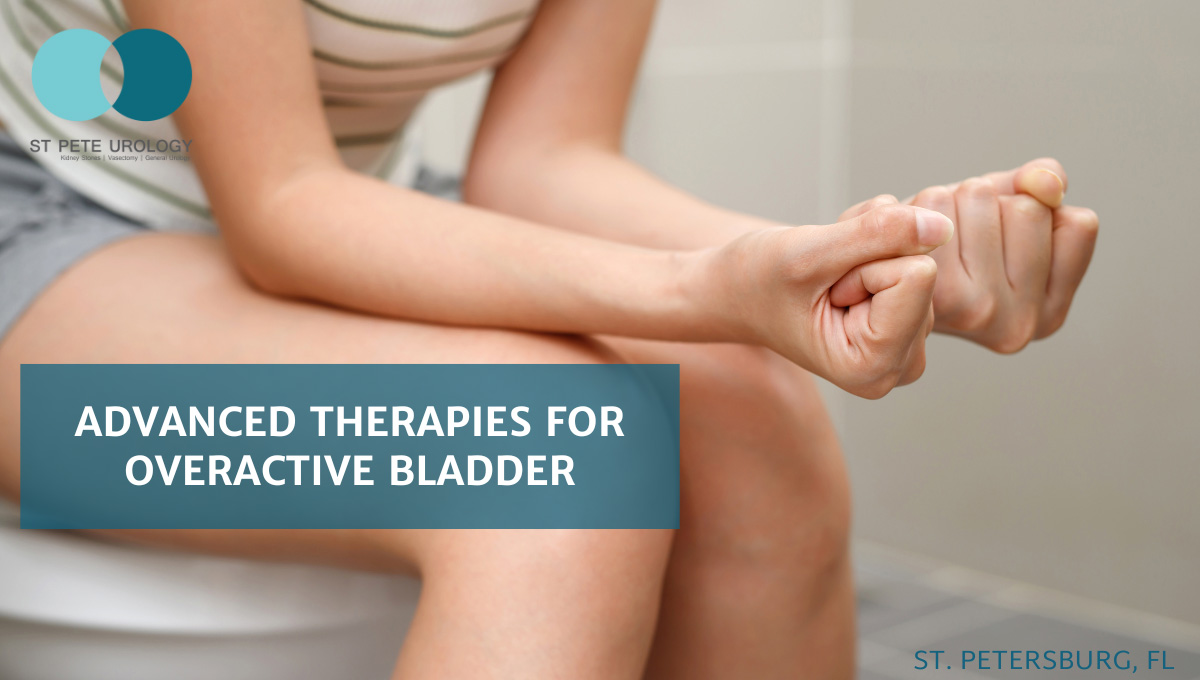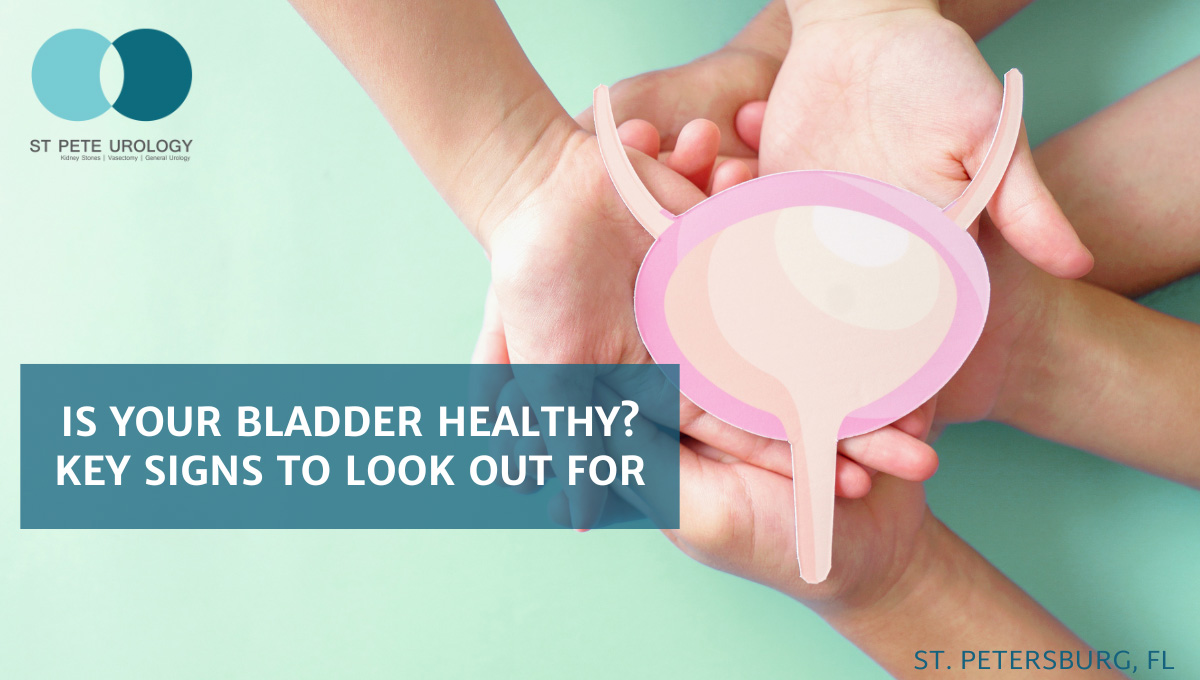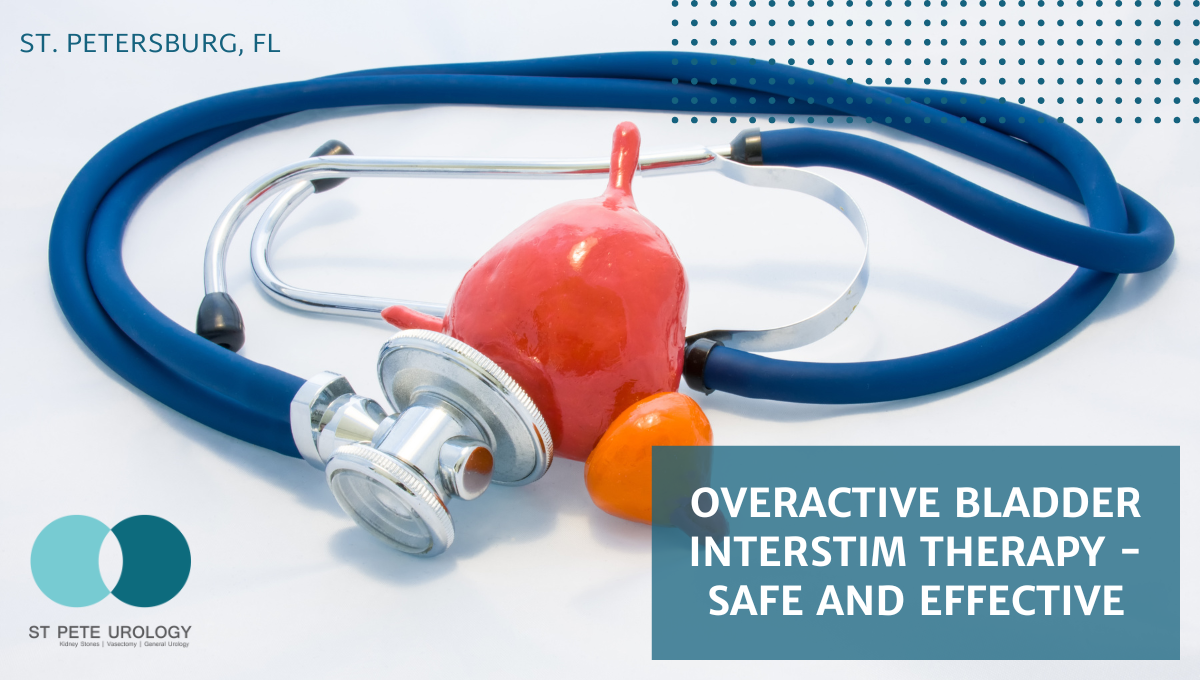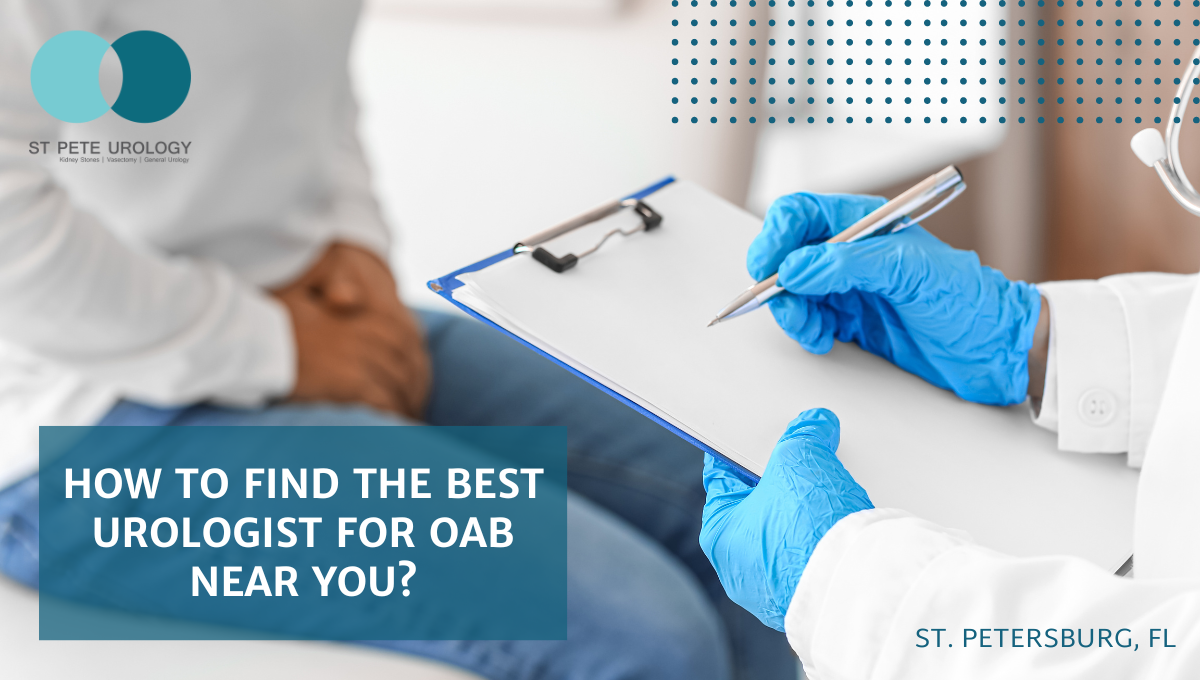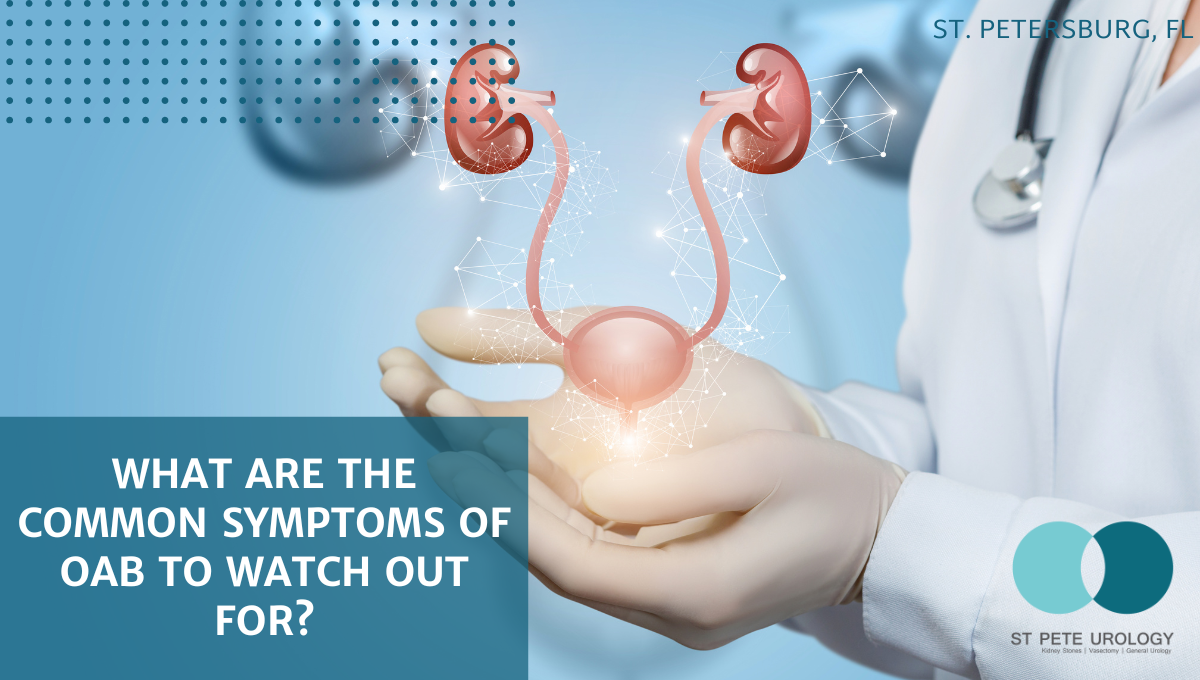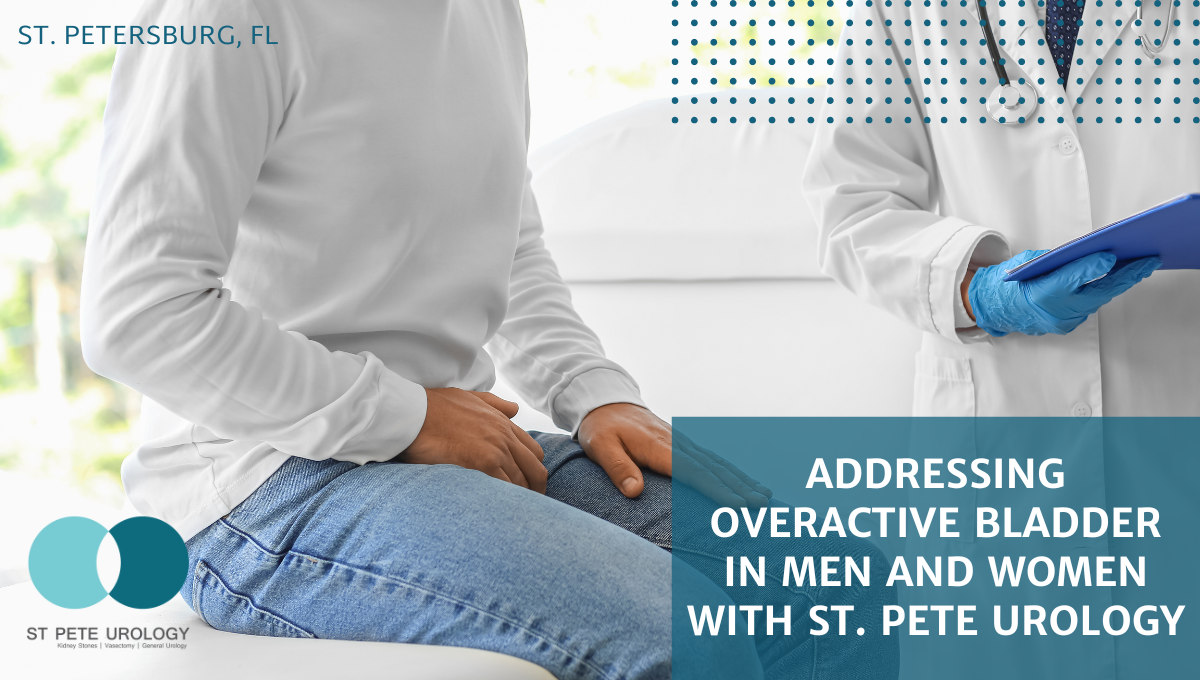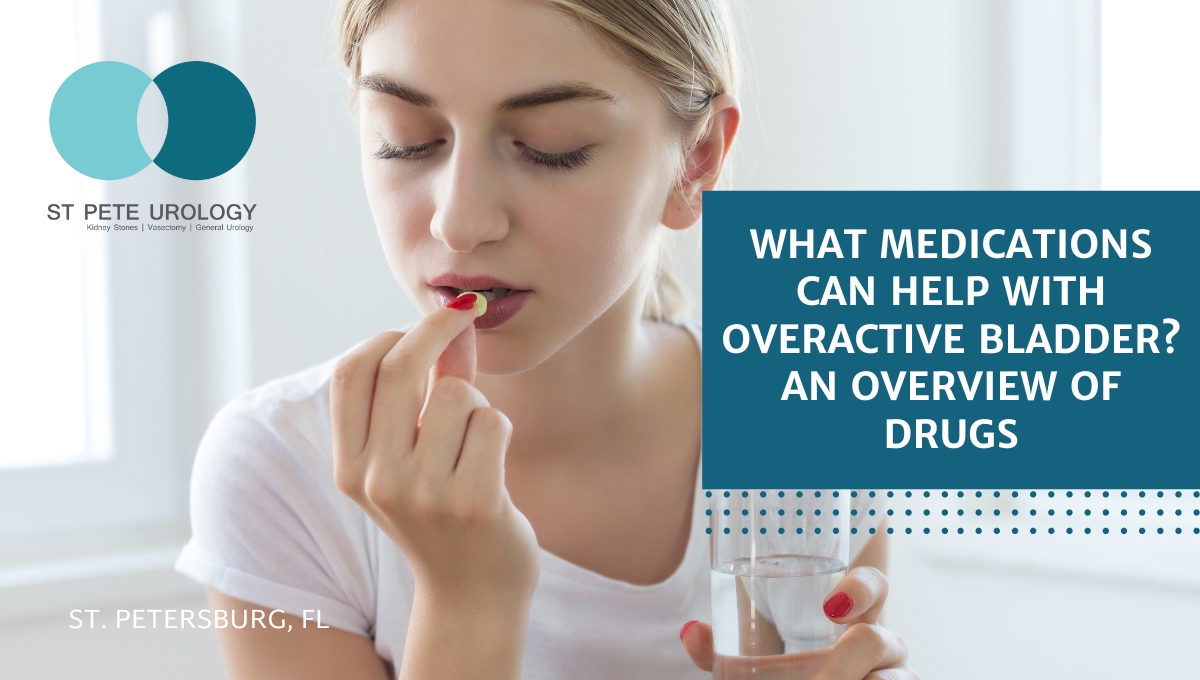Left untreated, overactive bladder can wreak havoc on daily life. Interrupted sleep, stress and anxiety are some of the effects of OAB.
Continue readingAdvanced Therapies for Overactive Bladder
Advanced therapies for overactive bladder include the Medtronic InterStim System, Botox injections and more. Learn more here at St Pete Urology.
Continue readingDifferent Treatment Options for Overactive Bladder
Understanding the different treatment options for overactive bladder will lead to a more accurate and personalized treatment plan.
Continue readingIs Your Bladder Healthy? Key Signs to Look Out For
Recognizing the key signs of a healthy bladder is important to monitor its condition and seek medical advice when necessary.
Continue readingOveractive Bladder InterStim Therapy – Safe and Effective
Key Takeaways:
- Urologists are trained and experienced in providing insight and professional care to those suffering from OAB.
- InterStim Therapy presents incredible efficacy for both bowel and bladder control.
- InterStim Therapy should be considered only after consultation with a urologist and when other measures have failed to yield desired results.
A Focus on Bowel and Bladder Control
When seeking an effective treatment for overactive bladder (OAB), it’s important to consult with a Urologist who specializes in this field. As Dr. Nicholas Laryngakis, a Urologist in St. Petersburg, FL, reveals, “the topic tonight is something that we do have a lot of focus in and enjoy taking care of and have a specialty in.” With years of training and experience, Urologists like Dr. Laryngakis offer insight and professional care to those suffering from OAB.
Effectiveness of the InterStim Therapy
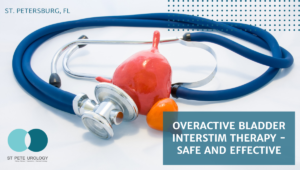

However, the therapy’s benefits extend beyond bowel concerns. It also stands as a highly effective solution for overactive bladder problems. Dr. Graves provides assurance that the impact of sacral nerve modulation on bladder issues is significant, with more than three-quarters of patients experiencing substantial improvement in their condition.
Is InterStim Therapy Right for You?
InterStim Therapy is not a first-line treatment. It’s considered when other measures, such as dietary changes, Kegel exercises, and medication, have failed to yield desired results. “It’s really a minor, you know, outpatient 15-minute procedure that really can change your life if you’re the right person for it and the right patient,” encourages Dr. Graves.
This therapy, however, is not for everyone. The decision for InterStim Therapy should be made only after thorough consultation with a well-versed urologist who can assess if the therapy is right for you.
St Pete Urology: Your Trusted Partner in Overcoming OAB
If you’re on the hunt for “Urologist for OAB Near Me” in St. Petersburg, FL, St Pete Urology comes highly recommended. Our team of specialist urologists, including Dr. Laryngakis and Dr. Graves, is dedicated to helping you regain control over your life.
At St Pete Urology, we understand how OAB can affect your day-to-day activities, self-esteem, and overall quality of life. We are committed to providing comprehensive care, from advice on lifestyle changes to advanced medical interventions like InterStim Therapy. With our patient-centric approach, you can be confident that you’re in good hands.
Fight back against overactive bladder. Take the first step towards a more fulfilling, worry-free life by consulting with our expert urologists today.
References:
- St Pete Urology. (2013, March 28). An Overactive Bladder Overview | St Pete Urology. St Pete Urology. https://stpeteurology.com/what-is-overactive-bladder/
- St Pete Urology. (2023, April 7). St. Pete Urology | Urologists in St Petersburg, Florida. St Pete Urology. https://stpeteurology.com/how-is-overactive-bladder-diagnosed-tests-and-exams-you-may-need/
- Medtronic. (2018). Questions and Answers About Medtronic’s Neurostimulation for Overactive Bladder. Medtronic.com. https://www.medtronic.com/uk-en/patients/treatments-therapies/neurostimulator-overactive-bladder/questions-answers.html
- Elad Leron, Weintraub, A. Y., Salvatore Andrea Mastrolia, & Schwarzman, P. (2018). Overactive Bladder Syndrome: Evaluation and Management. Current Urology, 11(3), 117–125. https://doi.org/10.1159/000447205
- Overactive Bladder. (2016). Medlineplus.gov; National Library of Medicine. https://medlineplus.gov/overactivebladder.html
How to Find the Best Urologist for OAB Near You?
Key Takeaways:
- Start your search for the best urologist for OAB with research and patient reviews and testimonials.
- Look for a urologist who offers advanced diagnostic and treatment options and a patient-centered approach.
- Ensure the urologist accepts your insurance and inquire about costs, co-payments, and deductibles.
You. Yes, you with the recurring restroom visits, who has Overactive Bladder (OAB) written in the margins of your life. Understandably, you’re more than ready to find the right urologist for OAB near you. Because, let’s face it, this isn’t just about a healthcare provider; it’s about changing your life.
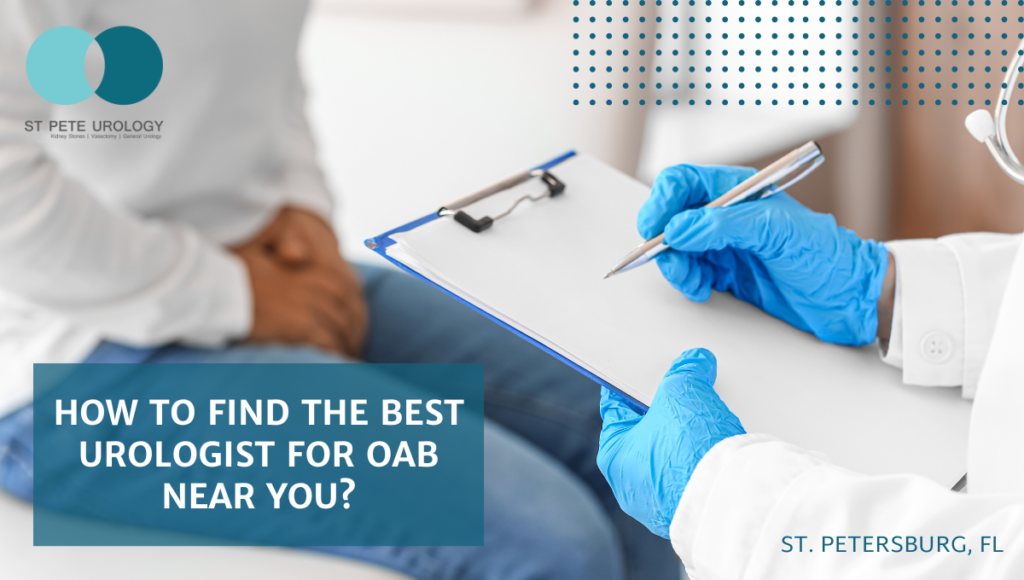

Introduction: Identifying OAB and Finding the Best Urologist
OAB is a condition marked by an uncontrollable urge to urinate, often accompanied by incontinence, nocturia, and frequency. It’s more than an inconvenience. It’s an unwelcome thief, stealing away your peace of mind. But with the right urologist, it’s treatable.
Researching Urologists in Your Area: Starting From the Right Point
Pinning down the right urologist starts with a healthy dose of research. Turn to the digital realm, leverage online search platforms and directories. “Urologist for OAB Near Me” should be your mantra. Don’t be shy about asking your primary care physician for recommendations. They’re in the industry and their advice can be invaluable. But remember, patient reviews and testimonials should be your compass.
Evaluating Urologists for OAB Treatment: Going Beyond the Surface
Beyond credentials and board certification, which frankly should be the minimum requirement, look for urologists with experience and specialization in OAB. Progressive urologists offering advanced diagnostic and treatment options are a plus. But remember, the most important factor should be a patient-centered approach – a urologist who talks with you, not at you.
Scheduling Initial Consultations: Making the First Move
Once you’ve narrowed down potential urologists, make that call. During consultations, ask about their approach towards managing OAB. Are conservative approaches, such as lifestyle changes, bladder training and pelvic floor exercises part of their plan? Also, consider your comfort level and rapport with the urologist.
Considering Treatment Options: Taking Control of Your Health
Examine their medication options and talk about potential side effects. Discuss advanced treatment options like neuromodulation, Botox, and minimally invasive procedures. Surgical options should also be on the table – evaluate the risks and benefits.
Insurance Coverage and Cost Considerations: Balancing Quality and Affordability
Ensure they accept your insurance and inquire about costs, co-payments, and deductibles. Discuss payment plans if necessary because quality care shouldn’t mean financial strain.
Follow-Up and Continuity of Care: Ensuring Long-term Management
Look for a urologist who values regular follow-up appointments and monitoring, and one who offers solid long-term management. The best urologists empower their patients with education.
Conclusion
Your journey to reclaim control of your life from OAB begins with finding the right urologist. It won’t always be easy, but when you find that provider who ticks all the right boxes – specialization in OAB, patient-centric approach, advanced treatment options, and strong follow-up care, it’s worth the search.
For those in St. Petersburg, FL, your search could end well at St Pete Urology. They combine advanced technology, innovative treatment options with a compassionate and patient-centered approach to OAB – it’s not just about treating symptoms, but about improving your overall quality of life.
References:
- St Pete Urology (2017, November 29). What is Overactive Bladder? St Pete Urology. https://stpeteurology.com/what-overactive-bladder/
- Elad Leron, Weintraub, A. Y., Salvatore Andrea Mastrolia, & Schwarzman, P. (2018). Overactive Bladder Syndrome: Evaluation and Management. Current Urology, 11(3), 117–125. https://doi.org/10.1159/000447205
- Higuera, V. (2019, January 17). Everything You Need to Know About Overactive Bladder. Healthline; Healthline Media. https://www.healthline.com/health/overactive-bladder
- Watson, S. (2016, May 25). Faces of Healthcare: What Is a Urologist? Healthline; Healthline Media. https://www.healthline.com/health/what-is-a-urologist
- The role of a urologist. (2023, March 30). Healthdirect.gov.au; Healthdirect Australia. https://www.healthdirect.gov.au/urologist
What Are the Common Symptoms of OAB to Watch Out For?
Key Takeaways:
- Common symptoms of overactive bladder (OAB) include frequent urination, urgency to urinate, nocturia, and urge incontinence.
- Common treatments for OAB include behavioral changes, medications, neuromodulation, electrical stimulation, and surgical interventions.
- Seeking medical attention from a qualified Urologist is the best way to ensure a prompt and accurate diagnosis and an effective, personalized treatment plan.
Understanding Overactive Bladder (OAB)
When it comes to health conditions that significantly affect daily life, overactive bladder (OAB) is one of those that sneaks in uninvited and leaves an indelible interruption. Overactive bladder is a rather common condition, characterized by the sudden need to urinate and difficulty controlling it, which can lead to frequent trips to the bathroom and potentially embarrassing situations. In the United States alone, around 33 million people are afflicted by this condition, highlighting the prevalence of the issue.
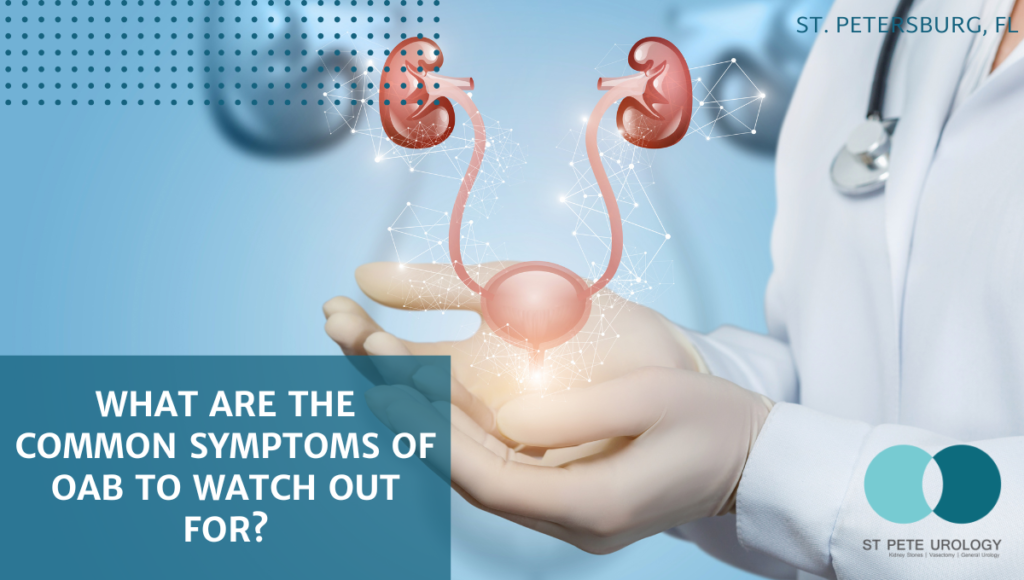

Recognizing the Symptoms of OAB
A symptom that’s virtually synonymous with an overactive bladder is frequent urination. This means needing to use the bathroom more than eight times within a 24-hour span. Root causes could be as diverse as high fluid intake, urinary tract infections, or an underlying medical condition. Regardless of the cause, the effect on a person’s life can be significant, leading to social embarrassment, anxiety, and disrupted daily routines.
The urgency to urinate, another cardinal sign of OAB, is an instantaneous, overwhelming impulse to pass urine. This can be triggered by something as simple as the sound of running water or arriving home. The key to managing this symptom lies in techniques like bladder training, which include creating a urination schedule and practicing delay techniques.
Another OAB symptom, nocturia, is defined as the need to wake up multiple times at night to urinate. Causes can range from excessive fluid intake before bedtime, to more serious issues like diabetes or prostate problems. This not only disrupts sleep patterns but can significantly impair a person’s overall quality of life.
The final symptom, urge incontinence, refers to the involuntary loss of urine immediately following the intense desire to urinate. Factors contributing to this can be conditions that affect nerve signals controlling bladder function. Thankfully, various treatment options exist, from pelvic floor exercises to medications and even surgical interventions.
Diagnosis and Treatment of OAB
Diagnosis typically begins with a thorough medical history and physical examination. Diagnostic tests include urinalysis, urodynamic testing, and in some cases, cystoscopy.
When it comes to treatment and management, behavioral changes such as bladder training, limiting fluid intake, and avoiding bladder irritants are usually the first line of action. Medications can also be employed to manage the symptoms. For more severe cases, neuromodulation and electrical stimulation are options to explore. And as a last resort, surgical interventions may be considered.
Seeking Medical Attention for OAB
While these symptoms may seem daunting, it’s essential to remember that relief is not out of reach. Be vigilant for red flags like blood in the urine, or symptoms that interfere with your daily life. A qualified Urologist can guide you on this health journey, ensuring a prompt and accurate diagnosis and an effective, personalized treatment plan.
It’s with this understanding of overactive bladder and its symptoms that you can take control of your health. Here in St. Petersburg, FL, ‘St Pete Urology‘ is a trusted provider of comprehensive urologic care. We take pride in guiding our patients through the often complex world of urologic health and strive for the best possible outcomes. Reach out to us today, and let’s work together towards achieving optimal urologic health.
References:
St Pete Urology. (2017, November 29). What is Overactive Bladder? St Pete Urology. https://stpeteurology.com/what-overactive-bladder/
St Pete Urology. (2023, March 7). St. Pete Urology | Urologists in St Petersburg, Florida. St Pete Urology. https://stpeteurology.com/what-causes-overactive-bladder-understanding-the-triggers/
- and, D. (2023, August 7). Bladder Control Problems (Urinary Incontinence) – NIDDK. National Institute of Diabetes and Digestive and Kidney Diseases. https://www.niddk.nih.gov/health-information/urologic-diseases/bladder-control-problems
- What Is Overactive Bladder (OAB)? – National Association For Continence. (2023, July 12). National Association for Continence. https://nafc.org/overactive-bladder/
- Urinalysis (urine test). (2016, August 8). National Kidney Foundation; https://www.kidney.org/atoz/content/what-urinalysis
- and, D. (2023, August 7). Urodynamic Testing. National Institute of Diabetes and Digestive and Kidney Diseases; NIDDK – National Institute of Diabetes and Digestive and Kidney Diseases. https://www.niddk.nih.gov/health-information/diagnostic-tests/urodynamic-testing
- NHS Choices. (2023). Overview – Cystoscopy. https://www.nhs.uk/conditions/cystoscopy/#:~:text=A%20cystoscopy%20is%20a%20procedure,or%20nurse%20to%20see%20inside.
Addressing Overactive Bladder in Men and Women with St. Pete Urology
Key Takeaways:
- Overactive bladder is a common condition affecting both men and women.
- There is a stigma surrounding overactive bladder that deters individuals from seeking treatment.
- St. Pete Urology is a medical practice that offers treatments to alleviate the discomfort of overactive bladder and improve patients’ quality of life.
Understanding the Overactive Bladder Predicament
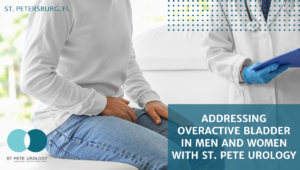

Men and Women: Equally Affected
This condition is not exclusive to women, as is often mistakenly assumed. Men too are victims of it. This false narrative that “women are the only ones that lose bladder control as they age” needs to be rectified. Men may need to undergo further evaluations to ensure that a prostate issue isn’t at the root of their condition.
The Stigma Around Overactive Bladder
This is a condition that often stays unaddressed due to the sensitivity and stigma surrounding it. Many people live in discomfort, limited by their ailment as they are deterred from seeking treatment. According to Dr. Laryngakis, “A lot of people are concerned and it is a sensitive area so they don’t always seek treatment…”. What is crucial in this context is the creation of a safe and confidential environment that allows individuals to comfortably discuss their predicament.
How St. Pete Urology Can Help
At St. Pete Urology, a compassionate team of professionals led by a board-certified Urologist, Dr. Laryngakis, works tirelessly to help patients regain control of their lives. The medical team prides itself on having open and confidential conversations with patients, aiming to soothe their apprehensions and create a space where they can freely express their concerns.
In the quest of addressing overactive bladder, you’re no longer alone. With an array of treatments available, St. Pete Urology aims to alleviate your discomfort, ensuring that you no longer feel the need for constant reassurance like the use of a pad or diaper.
St. Pete Urology, based in St. Petersburg, FL, is not just a medical practice. They are your allies in combating the challenges that come with an overactive bladder. In their efforts to improve patients’ quality of life, they strive to create an environment where patients feel comfortable discussing their intimate medical issues. So, break free from the burden of an overactive bladder and regain the freedom to live your life fully. Reach out to St. Pete Urology today — your journey towards a healthier, happier, and more confident you begins here.
References:
- St Pete Urology. (2013, March 28). An Overactive Bladder Overview | St Pete Urology. St Pete Urology. https://stpeteurology.com/what-is-overactive-bladder/
- Elad Leron, Weintraub, A. Y., Salvatore Andrea Mastrolia, & Schwarzman, P. (2018). Overactive Bladder Syndrome: Evaluation and Management. 11(3), 117–125. https://doi.org/10.1159/000447205
- Overactive bladder – Diagnosis and treatment – Mayo Clinic. (2022). Mayoclinic.org; https://www.mayoclinic.org/diseases-conditions/overactive-bladder/diagnosis-treatment/drc-20355721
- Overactive Bladder. (2016). Medlineplus.gov; National Library of Medicine. https://medlineplus.gov/overactivebladder.html
Transcription:
Hi, I’m Dr. Nicholas Laryngakis, board certified urologist with St. Pete Urology. Inflammatory bladder is a very common disease process that occurs to both men and women. So as we age, often the bladder becomes more sensitive and reflexive, leading to some people having a lot of frequency and urgency and even leakage of urine called incontinence. And that really affects their quality of life because they’re always having to go to the bathroom and don’t feel comfortable going out into the world without some sort of reassurance such as a pad or a diaper even unfortunately in some people. So there is a lot of treatments we have to help patients with that. A lot of people are concerned and it is a sensitive area so they don’t always seek treatment but here at St. Pete Urology, we’re very open with patients, we have confidential conversations and try to help them with these kind of problems. That women are the only ones that lose bladder control as they age but it can occur in men. Often men have to be evaluated a little further to make sure it’s not a prostate issue.
How is Overactive Bladder Diagnosed? Tests and Exams You May Need
Key Takeaways:
1. OAB is a common bladder condition that affects over 200 million people globally, potentially impacting an individual’s quality of life.
2. Accurate diagnosis of OAB can be made through physical examination, bladder tests and imaging tests.
3. Treatment for OAB typically includes lifestyle changes, medications, and behavioral therapy. St Pete Urology is an excellent provider for diagnosis and treatment in the St. Petersburg area.


Diagnosis of Overactive Bladder
The first step towards an accurate diagnosis of OAB is to make a thorough patient medical history to review prior medical history and possible underlying medical conditions that could be contributing to OAB. After an initial review, a physical examination is the next necessary step. The physical examination can provide important clues as to the possible causes of the OAB symptoms. After physical examination, bladder tests and imaging tests are the most common tests used to diagnose OAB with accurate precision.
Bladder Function Tests:
To better understand the individual’s bladder functionality, bladder function tests can be carried out. This includes urine flow tests and post-void residual (PVR) tests. Urine flow tests measure the flow rate of urine and the PVR tests measure how much urine is left in the bladder after urination. These tests give important information on the type of OAB and how it is being managed.
Imaging Tests:
Additionally, if other tests yield inconclusive results, healthcare providers may employ imaging tests to diagnose OAB. These tests have the capability to display images of the bladder and urinary tract, aiding in the identification of any underlying issues. These issues may include a blocked or narrowed urethra and abnormalities in bladder muscles or valves. Also, the presence of other underlying conditions like bladder stones or tumors.
Treatment of Overactive Bladder
Once an individual has been diagnosed with OAB, treatments to manage it can be initiated. These treatments are broken down into lifestyle changes, medications, and behavioral therapy.
Lifestyle Changes:
Making lifestyle changes is always the first step to managing OAB. Lifestyle includes reducing substance use, i.e. caffeine, alcohol or other stimulants, that can irritate the bladder. Limiting intake of fluids before bed, potential allergies to certain foods, managing stress, and increasing physical activity levels can also help to reduce pain and symptoms of OAB.
Medication:
If lifestyle changes don’t provide enough relief, medications are typically the second step in the treatment plan. Although these medications can help to reduce OAB symptoms, they can also produce unwanted side effects. Therefore, it is important to review all potential risks and side effects with your doctor before taking any medication.
Behavioral Therapy:
Behavioral therapy is another treatment type for OAB. This type of therapy is designed to help individuals gain better control of their bladders. The therapy helps to build awareness of the body’s signals when the bladders have reached a certain capacity and teaches individuals to delay or prevent urge responses.
Conclusion
Overactive bladder is a condition that affects many people and can cause significant discomfort and disruption to an individual’s daily activities. Accurate diagnosis of OAB can be made through physical examination, bladder tests and imaging tests. Once diagnosis is complete, treatment can begin. Treatments for OAB typically include lifestyle changes, medications, and behavioral therapy. Early diagnosis and treatment of OAB can help to reduce symptoms and improve quality of life.
St Pete Urology is a premier urology practice and leader in diagnosing and treating OAB in the St. Petersburg, Florida area. St Pete Urology’s dedicated team of highly experienced specialists and professional staff members work together to provide you with the best possible treatment so you can get back to living a life free from OAB symptoms and discomfort.
References:
- “Urodynamic Testing: What Is It, Procedure & What To Expect.” 17 Aug. 2020, https://my.clevelandclinic.org/health/diagnostics/15684-urodynamic-testing.
- “Overactive bladder (OAB) and lifestyle modification – Female Urology.” https://www.urineincontinence.com.au/overactive-bladder/overactive-bladder-oab-and-lifestyle-modification.
- “Diagnosing Overactive Bladder – WebMD.” 7 Jun. 2022, https://www.webmd.com/urinary-incontinence-oab/overactive-bladder-making-diagnosis.
What Medications Can Help with Overactive Bladder? An Overview of Drugs
Key Takeaways:
1. Overactive Bladder (OAB) is a common condition affecting millions of people across the United States.
2. Anticholinergics and mirabegron are the most common medications prescribed for OAB, but there are other medications available on a case-by-case basis.
3. St. Pete Urology provides comprehensive care for patients with OAB and other urological issues.


I. Introduction
A. Definition of Overactive Bladder (OAB)
OAB is defined as a condition in which the bladder muscles contract involuntarily without warning. This makes it difficult for the person to control their urination. OAB can occur at any age, but it is more common in adults over the age of 40. Additionally, women are more likely to have OAB than men.
B. Describe Overview of OAB Symptoms
The primary symptoms of OAB include a sudden and frequent need to urinate, urinary urgency, and urinary incontinence. These symptoms can make it difficult to go about daily activities, such as going to work or school, exercising, and participating in social events. Other common symptoms of OAB include sleeplessness, difficulty concentrating, and irritability.
II. Symptoms and Diagnosis
A. Symptoms of OAB
The symptoms of OAB can vary from person to person, but the most common symptoms include a sudden and frequent need to urinate, urinary urgency, and urinary incontinence. Other symptoms may include difficulty sleeping, difficulty concentrating, and irritability.
B. Diagnosing OAB
If a person suspects they may be suffering from OAB, they should see their primary care physician or a specialist such as a urologist. The doctor may order a variety of tests, such as a urinalysis or bladder ultrasound, to determine if the person has OAB.
III. Treatment Options for OAB
A. Self-Care Measures for OAB
In many cases, self-care measures can help reduce the symptoms of OAB. These include increasing fluid intake, managing stress, avoiding certain foods and drinks that can irritate the bladder, avoiding alcohol, and using the bathroom regularly.
B. Medications for OAB
In some cases, medications may be prescribed to help manage the symptoms of OAB. These medications can be divided into two categories: anticholinergic medications and mirabegron.
1. Anticholinergic Medications
Anticholinergic medications are medications that work by blocking the action of a neurotransmitter called acetylcholine. This helps to relax the muscles of the bladder and reduce the urge to urinate.
2. Mirabegron
Mirabegron is a medication that is classified as a beta-3 agonist. It works by stimulating the bladder muscles, allowing them to hold more urine. This helps reduce the urge to urinate.
3. Other Medications
Other medications may be prescribed if the patient does not respond to anticholinergics or mirabergon. These medications are typically used on a case-by-case basis and may include antispasmodics, antidepressants, and alpha-blockers.
IV. Side Effects of OAB Medications
A. Anticholinergic Medications
Common side effects of anticholinergic medications include dry mouth, constipation, blurred vision, dizziness, and difficulty concentrating. These medications can also interfere with the absorption of certain vitamins and minerals from the gut.
B. Mirabegron
Common side effects of mirabegron include headache and flushing. These side effects usually resolve on their own, but if they persist you should speak to a healthcare provider.
V. Conclusion
A. Wrap Up Overall Information on OAB Medications
In conclusion, there are a variety of medications available to help manage the symptoms of OAB. Anticholinergic medications and mirabegron are the most commonly prescribed medications, but other medications may be used in certain cases. It is important to discuss all treatment options with a doctor and to be aware of any potential side effects or contraindications.
At St. Pete Urology, we provide comprehensive care for patients with bladder control problems and other urological issues. Our board-certified urologists and highly trained staff are prepared to help you take control of your bladder. We offer the latest treatment options and provide personalized, compassionate care. Contact us today to learn more about how we can help you manage your OAB symptoms.
References:
- “Overactive Bladder (OAB) in Women – Urology Associates.” https://www.denverurology.com/female-urology/oab/.
- “Anticholinergic Medications for Overactive Bladder – Healthline.” https://www.healthline.com/health/overactive-bladder/anticholinergic-medications.
- “Overactive Bladder | Polyuria – MedlinePlus.” 15 Sep. 2016, https://medlineplus.gov/overactivebladder.html.


